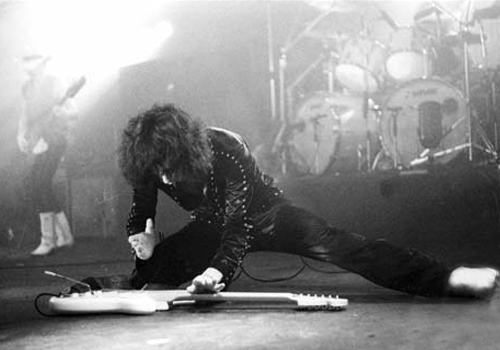|
Ritchie Blackmore Dawk Limited Sound  I actually started working for Deep Purple around 1972, Roger Glover and Ian Pace were producing the opening act "Elf" and I had been working for the Elves/Elf for at least ten years by then. It was Roger Glover that came to me after seeing Ronnie Dio's EBO bass with two extra Jazz Bass pickups installed on it, he liked the sound so much he wanted me to do the same to his Rick 4001. Then Deep Purple broke up, Ritchie basically taking Elf to start his project "Rainbow" and that's where I return to do all the band's gear, this was 1975 when I flew to LA to begin my work. The members being: Ronnie James Dio, Jimmy Bain, Tony Kerry, Cozy Powel and Ritchie Blackmore were rehearsing on a movie sound stage with rented equipment. I had just arrived from the airport and set up my tools in this little room used for lighting gels, when Ritchie handed me his Strat and said "Make it stay in tune!". Needless to say I pulled an all nighter, with jetlag to set up his guitar before rehearsal that next day. Then I put his guitar in his road case and went to sleep on top of it - at that point I could have slept anywhere - only to be awakened a few hours later by Fergie to start that day's rehearsals. The rehearsal were cut short, only to see Ritchie's limo pull up inside the huge sound stage. To my surprise he left playing his Strat all the way to the car. I was told the next day that he took it to the famous "Rainbow Bar & Grill" and showed everyone there how it would stay in tune! The next day as the band started their set I began working on one of Ritchie's spare boat anchors "The 200 Watt Marshall Major". It had a factory mod - a cascading circuit of the first channel into the second with a master volume control in between - the master volume pot was put in one of the input jacks to save time, it worked and was very loud but it had a duff tone and no high end cut. So I took all that stuff out and added an extra preamp tube with all of the correct voicing (EQ) that Ritchie liked. Yeah, you could even use the stock inputs to compare the stock sounds. I get a lot of questions about the Strat's scalloped necks. I can't take credit for that idea, as Ritchie explained to me he had bought an used acoustic guitar in England and it was so worn out that the wood between the frets were scoped out from the player's finger nails. I was sent to Ritchie's house to pick up a 100 watt (1959) Marshall amp to install the extra tube with a master gain for use as a club amp. He was eating breakfest and with a serrated knife was carving out the wood between the frets, I looked on with interest and said "Why don't you let me do my thing on this because you are making a mess". Well, that was it! I did my own thing and Ritchie liked it so much that I did all of his guitars that way. Tone controls: some guitar magazines say they were disconnected which was untrue. I had designed a tuned filter to get him a creamy sound. I used the "Q" factor of the pickups for my center point to select the right parts to make the tone circuit work correctly. Well, that's it for now, as you can see I've only scratched the surface on this subject... The rest will be in my book! © Dawk Stillwell, Dawk Limited Sound. |